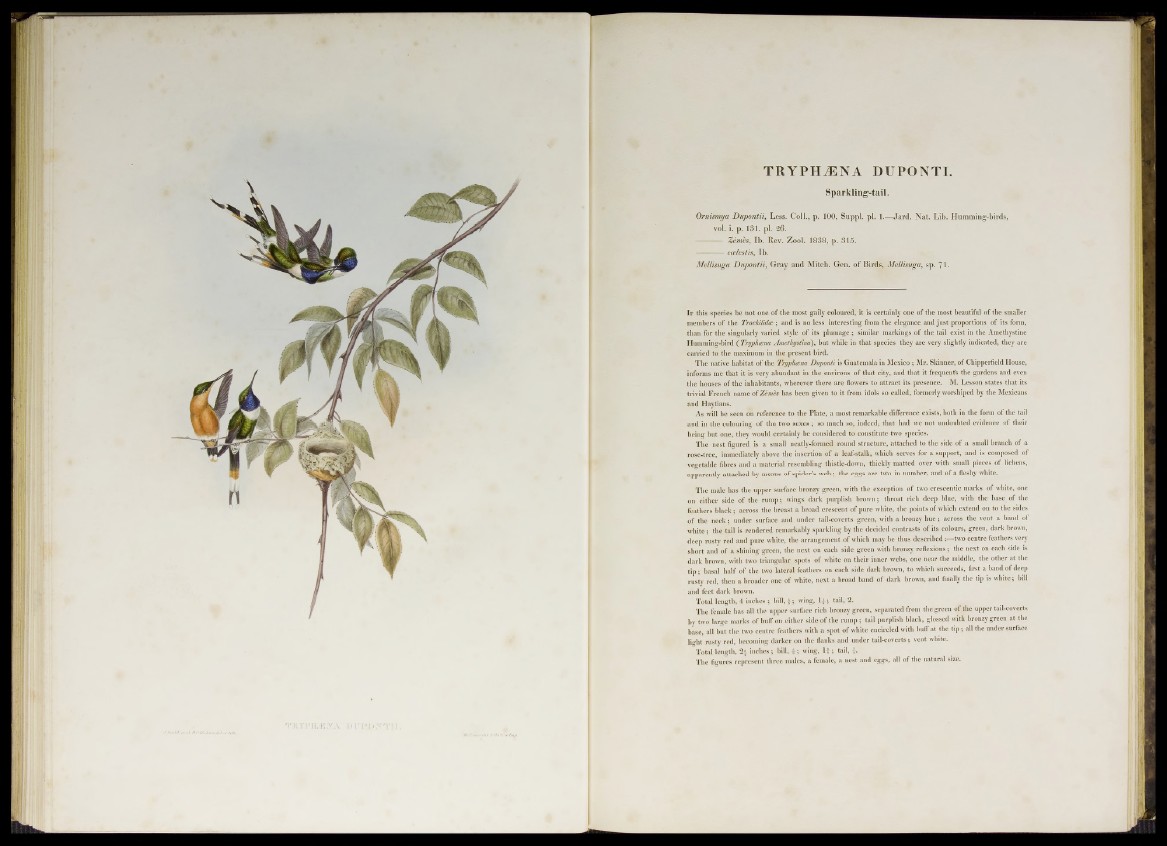
TRYPH^ENA d u p o n t i .
Sparkling-tail.
Ornismya Dupontii, Less. Coll., p. 100, Suppl. pi. 1.— Jard. Nat. Lib. Humming-birds,
vol. i. p. 131. pi. 26.
----------- Zemes, lb . Rev. Zool. 1838, p. 315.
— ccelestis, lb.
Mellisuga Dupontii, Gray and Mitch. Gen. o f Birds, Mellisuga, sp. 71*
If this species be not one of the most gaily coloured, it is certainly one of the most beautiful of the smaller
members of the Trochilidce; and is no less interesting from the elegance and just proportions of its form,
than for the singularly varied style of its plumage ; similar markings of the tail exist in the Amethystine
H umming-hird ('Tryp/cem Amethystind), but while in that species they are very slightly indicated, they are
carried to the maximum in the present bird.
The native habitat of the Tryphtena Duponti is Guatemala in Mexico ; Mr. Skinner, of Chipperfield House,
informs me that it is very abundant in the environs of that city, and that it frequents the gardens and even
the houses of the inhabitants, wherever there are flowers to attract its presence. M. Lesson states that its
trivial French name of Zemes has been given to it from idols so called, formerly worshiped by the Mexicans
and Haytians.
As will be seen on reference to the Plate, a most remarkable difference exists, both in the form of the tail
and in the colouring of the two sexes ; so much so, indeed, that had we not undoubted evidence of their
being but one, they would certainly be considered to constitute two species.
The nest figured is a small neatly-formed round structure, attached to the side of a small branch of a
rose-tree, immediately above the insertion of a leaf-stalk, which serves for a support, and is composed of
vegetable fibres and a material resembling thistle-down, thickly matted over with small pieces of lichens,
apparently attached by means of spider’s web; the eggs are two in number, and of a fleshy white,
The male has the upper surface bronzy green, with the exception of two crescentic marks of white, one
on either side of the rump; wings dark purplish brown; throat rich deep blue, with the base of the
feathers black; across the breast a broad crescent of pure white, the points of which extend on to the sides
of the neck; under surface and under tail-coverts green, with a bronzy hue; across the vent a band of
white; the tail is rendered remarkably sparkling by the decided contrasts of its colours, green, dark brown,
deep rusty red and pure white, the arrangement of which may he thus described :■—two centre feathers very
short and of a shining green, the next on each side green with bronzy reflexions; the next on each side is
dark brown, with two triangular spots of white on their inner webs, one near the middle, the other at the
tip; basal half of the two lateral feathers on each side dark brown, to which succeeds, first a band of deep
rusty red, then a broader one of white, next a broad band of dark brown, and finally the tip is white; bill
and feet dark brown.
Total length, 4 inches ; bill, 4; wing, 14; tail, 2.
The female has all the upper surface rich bronzy green, separated from the green of the upper tail-coverts
by two large marks of buff on either side of the rump; tail purplish black, glossed with bronzy green at the
base, all but the two centre feathers with a spot of white encircled with buff at the tip; all the under surface
light rusty red, becoming darker on the flanks and under tail-coverts; vent white.
Total length, 2 f inches ; bill, 4 ; wing, 14; tail, 4-
The figures represent three males, a female, a nest and eggs, all of the natural size.